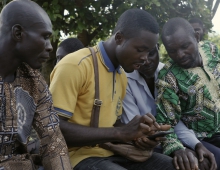
Mobile-broadband Penetration Approaching 32 Percent
New figures released by ITU indicate that, by end 2014, there will be almost 3 billion Internet users, two-thirds of them coming from the developing world, and that the number of mobile-broadband subscriptions will reach 2.3 billion globally. Fifty-five per cent of these subscriptions are expected to be in the developing world.
"The newly released ICT figures confirm once again that information and communication technologies continue to be the key drivers of the information society," said ITU Secretary-General Hamadoun I. Toure.
Results show that fixed-telephone penetration has been declining for the past five years. By end 2014, there will be about 100 million fewer fixed-telephone subscriptions than in 2009.
Mobile-cellular subscriptions will reach almost 7 billion by end 2014, and 3.6 billion of these will be in the Asia-Pacific region. The increase is mostly due to growth in the developing world where mobile-cellular subscriptions will account for 78 per cent of the world’s total.
Data show that mobile-cellular growth rates have reached their lowest-ever level (2.6% globally), indicating that the market is approaching saturation levels.
Africa and Asia and the Pacific, where penetration will reach 69 per cent and 89 per cent, respectively by end 2014, are the regions with the strongest mobile-cellular growth (and the lowest penetration rates). Penetration rates in the Commonwealth of Independent States (CIS), Arab States, the Americas and Europe have reached levels above 100 per cent and are expected to grow at less than two per cent in 2014. The region with the highest mobile-cellular penetration rate is the CIS.
By end 2014, fixed-broadband penetration will have reached almost 10 per cent globally.
Forty-four per cent of all fixed-broadband subscriptions are in Asia and the Pacific, and 25 per cent are in Europe. In contrast, Africa accounts for less than 0.5 per cent of the world’s fixed-broadband subscriptions, and despite double-digit growth over the last four years, penetration in Africa remains very low.
Africa, the Arab States, and CIS are the only regions with double-digit fixed-broadband penetration growth rates. The Americas region stands out with the lowest growth in fixed broadband penetration, estimated at 2.5 per cent and reaching a penetration rate of around 17 per cent by end 2014. Europe’s fixed-broadband penetration is much higher compared with other regions and almost three times as high as the global average.
Globally, mobile-broadband penetration will reach 32 per cent by end 2014; in developed countries, mobile-broadband penetration will reach 84 per cent, a level four times as high as in developing countries (21%). The number of mobile-broadband subscriptions will reach 2.3 billion globally and 55 per cent of all mobile-broadband subscriptions are expected to be in the developing world.
Mobile-broadband penetration levels are highest in Europe (64%) and the Americas (59%), followed by CIS (49%), the Arab States (25%), Asia-Pacific (23%) and Africa (19%).
By end 2014, 44 per cent of the world’s households will have Internet access. Close to one-third (31%) of households in developing countries will be connected to the Internet, compared with 78 per cent in developed countries. The analysis shows that household Internet access is approaching saturation levels in developed countries.
More than one out of two households in the CIS will be connected to the Internet. In Africa, only about one out of ten households will be connected to the Internet. However, household Internet access in Africa continues to grow at double-digit rates.
By end 2014, the number of Internet users globally will have reached almost 3 billion. Two-thirds of the world’s Internet users are from the developing world. This corresponds to an Internet-user penetration of 40 per cent globally, 78 per cent in developed countries and 32 per cent in developing countries. More than 90 per cent of the people who are not yet using the Internet are from the developing world.
In Africa, almost 20 per cent of the population will be online by end 2014, up from 10 per cent in 2010.
In the Americas, close to two out of three people will be using the Internet by end 2014, the second highest penetration rate after Europe. Europe’s Internet penetration will reach 75 per cent (or three out of four people) by end 2014, the highest worldwide. One-third of the population in Asia and the Pacific will be online by end 2014 and around 45 per cent of the world’s Internet users will be from the Asia-Pacific region.





















